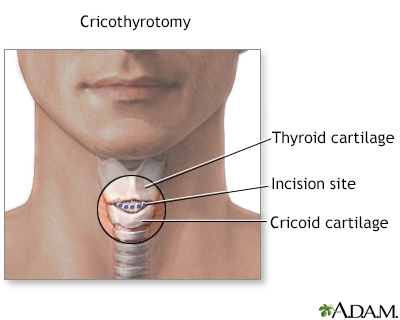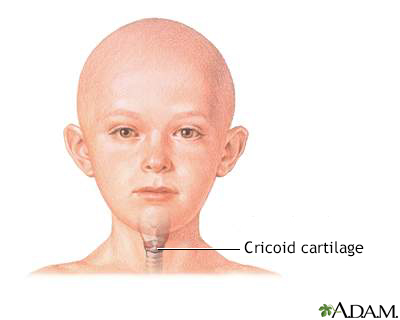Emergency airway puncture
 Print-Friendly
Print-Friendly
Needle cricothyrotomy
Emergency airway puncture is the placement of a hollow needle into the airway through the skin of the throat. It is done to treat life-threatening choking.
Emergency airway puncture is done in an emergency situation, when someone is choking and all other efforts to assist with breathing have failed.
- A hollow needle or tube can be inserted into the throat, just below the Adam's apple (thyroid cartilage), into the airway. The needle passes through the skin then between the thyroid cartilage and the cricoid cartilage.
- In a hospital, before inserting the needle, a small cut may be made in the skin and the membrane between the thyroid and cricoid cartilages.
I Would Like to Learn About:
Why the Procedure Is Performed
A needle cricothyrotomy is an emergency procedure to relieve an airway obstruction until surgery can be done to place a breathing tube (tracheostomy or surgical cricothyrotomy).
If the airway blockage occurs with trauma to the head, neck, or spine, care must be taken to avoid further injury to the person.
Risks
Risks for this procedure include:
- Injury to the voice box (larynx), thyroid gland, or esophagus
Risks for any surgery are:
- Bleeding
- Infection
Outlook (Prognosis)
How well the person does depends on the cause of the airway blockage and how quickly the person receives proper breathing support. Emergency airway puncture provides enough breathing support for only a very short period of time.
Related Information
| Abdominal thrusts...Breathing difficul...Tracheostomy |
References
Cavallone LF, Cattano D, Piacentini AGG. Percutaneous emergency airway access. In: Hagberg C, ed. Hagberg and Benumof's Airway Management. 5th ed. Philadelphia, PA: Elsevier; 2023:chap 28.
Hebert RB, Thomas D. Cricothyrotomy and percutaneous translaryngeal ventilation. In: Roberts JR, Custalow CB, Thomsen TW, eds. Roberts and Hedges' Clinical Procedures in Emergency Medicine and Acute Care. 7th ed. Philadelphia, PA: Elsevier; 2019:chap 6.







